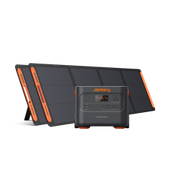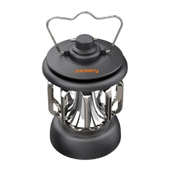Best Backpacking Solar Panel: Types, Best Pick, How to Choose
Whether you want to explore more of your surroundings or choose to go across the globe, backpacking can be a hugely rewarding experience. It's a stress buster that connects you with the surroundings, but how long can you go without your electronic devices like smartphones? Luckily, you don't have to worry about powering appliances, especially when you have backpacking solar panels.

You might assume these solar power panels are just too big, but this isn't the case. Jackery provides portable solar panels ranging from 40W of rated power all the way up to 200W. Each of them features the most energy-efficient monocrystalline silicon solar cells with a high waterproof rating. They are compatible with Jackery Explorer Portable Power Stations and can charge appliances during backpacking trips.
|
Products |
Image |
Output |
Efficiency |
Cell |
Dimensions |
|
|
200W |
24.3% |
Monocrystalline Silicon Solar Cells |
Folded: 21.2 x 24.2 x 1.6 in (540 x 615 x 40 mm)
Unfolded: 21.2 x 91.3 x 1 in (540 x 2320 x 25 mm) |
|
|

|
100W |
24.3%
|
Monocrystalline Silicon Solar Cells
|
Folded: 24 x 21 x 1.4 in (610 x 535 x 35 mm)
Unfolded: 48 x 21 x 0.2 in (1220 x 535 x 5 mm) |
|
|
SolarSaga 40W Solar Panels (Compatible with Explorer 300 Plus) |

|
40W |
— |
Monocrystalline Silicon Solar Cells |
Folded: 252 x 300 x 20 mm
Unfolded: 970 x 300 x 2.5 mm |
What Is Backpacking Solar Panels?
Backpacking solar panels are compact-sized, portable charging solutions that are easy to install and can be carried anywhere. Like typical solar panels, they work by converting sunlight into electricity and storing power in a compatible battery.
These solar panels are connected to the battery or power station to store the generated electricity. The combination of solar panels and battery backup will help you power most small appliances like smartphones, laptops, cameras, and more.
But before you plan to invest in the best backpacking solar panels, it's vital to understand the power supply chain. It typically consists of three things — power source (for example, solar panels), power storage (for example, portable battery backup), and power use.

What Are The Types of Backpacking Solar Panels?
There are three main types of best solar panels for backpacking: monocrystalline, polycrystalline, and thin-film. They vary in appearance, costs, performance, and their manufacturing materials.
- Monocrystalline Solar Panels: Out of all solar panel types, monocrystalline solar panels are the most highly efficient and expensive option made with single silicon crystal.
- Polycrystalline Solar Panels: They are cheaper than monocrystalline solar panels produced from silicon fragments rather than a single, pure silicon crystal.
- Thin-film Solar Panels: They are one of the least efficient solar panels used more often in large industrial spaces.
|
Solar Panels |
Pros |
Cons |
|
Monocrystalline Solar Panels
|
- Built with highest-grade silicon cells - Lasts more than 25 years - Requires less space for installation |
- Expensive compared to the other two panel types - Might be slightly less efficient during cold weather |
|
Polycrystalline Solar Panels
|
- More affordable than monocrystalline solar panels - Produces less waste during the production process |
- Less efficient than monocrystalline panels
|
|
Thin-film Solar Panels
|
- Are the least expensive panel option - Lightweight and more flexible |
- Least efficient among all three solar panel types
|
If you want to charge appliances during backpacking, there are three popular options: a small solar charger, a panel-only solar charger, and a solar generator.
Small Solar Charger: Also known as on-device solar chargers, these personal devices have small, built-in basic solar panels. They intend to charge the appliances they're built into, like power banks or lanterns.
Panel-Only Solar Chargers: They work by converting sunlight into electricity but do not have a place to store the power. For this reason, you'll need a compatible power station or power bank to hold charge and supply electricity to appliances.
Solar Generator: This charging solution combines solar panels and power stations to power most electrical appliances like cell phones, laptops, cameras, etc. They are great backpacking companions that keep you powered even if you are away from electrical outlets.
How Does Packing Solar Panels Work?
Just like standard solar panels, backpacking solar panels are made of silicon cells and involve the photovoltaic effect to convert the sun's rays into electricity.
The photovoltaic process starts when the sunlight hits the solar panels and excites the electrons in silicon atoms. When all the excited electrons get excited, they start moving and produce an electrical current.
The electricity produced by the solar power panels is stored in the power station or battery backup with a built-in inverter. The core aim of this inverter is to convert DC to AC electricity, which is then used to power appliances.
Jackery Solar Generators combine SolarSaga Solar Panels and Explorer Portable Power Stations to charge most backpacking gear. The diagram illustrates how the Jackery Solar Generator works to charge electrical devices.

Best Backpacking Solar Panels with Jackery
Solar power is a great way to generate electricity using the sun, which can be used to recharge backpacking devices and other essential gear. Jackery SolarSaga Solar Panels are compact in size and lightweight charging solutions compatible with Jackery power stations and other third-party battery backups.
Jackery SolarSaga 100W Solar Panels
Jackery SolarSaga 100W Solar Panels weigh only 10.33 lbs and are ideal for backpacking. It is equipped with adjustable stands and has a solar efficiency of 24.3%, making it suitable for generating maximum electricity and charging the power station.
These solar panels have an IP65 waterproof rating, making them suitable for camping in mild rain or in harsh and wet weather. It also features 1*USB-A (5V, 2.4A) and 1*USB-C (5V, 3A) to charge two small devices like tablets and phones.

Customer Review
“This thing is so cool! Took it camping for a week, and using Jackery 300 and the 100w solar panel was plenty for keeping devices charged and the occasional re-inflation of air mattresses for 6+ people. I feel better prepared for the next power outage at home, too.” — GarretMueller
|
Explorers |
No. of Panels |
Recharging Time |
Capacity |
Backpacking Electronics |
|
Explorer 500 |
1 |
9H |
518Wh |
Phone (24W): 22.6H Light (5W): 108.6H Fan (15W): 36.2H Camera (5W): 108.6H GPS (50W): 10.8H Drone (60W): 9H |
|
Explorer 300 Plus |
1 |
3.4H |
288Wh |
Phone (24W): 11.6H Light (5W): 49H Fan (15W): 16H Camera (5W): 49H GPS (50W): 4.8H Drone (60W): 4H |
|
Explorer 240 v2 |
1 |
5H |
256Wh |
Phone (24W): 9.0H Light (5W): 43.5H Fan (15W): 14.5H Camera (5W): 43.5H GPS (50W): 4.3H Drone (60W): 3.6H |
Jackery SolarSaga 40W Solar Panels
Jackery SolarSaga 40W Solar Panels is one of the most portable and lightweight charging solutions compatible with Explorer 300 Plus. These iPad-sized solar panels can easily fit your backpack and recharge the power station in only a few hours. Jackery Explorer 300 Plus and SolarSaga 40W Solar Panels weigh only 11 lbs, making it a smart choice for outdoor adventures.

|
Explorers |
No. of Panels |
Recharging Time |
Wh Energy
|
Backpacking Electronics |
|
Explorer 300 Plus |
1 |
9.5H |
288Wh (Capacity of only Explorer 300 Plus)
|
Phone (24W): 11.6H Light (5W): 49H Fan (15W): 16H Camera (5W): 49H GPS (50W): 4.8H Drone (60W): 4H |
How to Choose The Backpacking Solar Panel?
The best backpacking solar panels will depend on a few factors, such as power output, size, weight, battery capacity, and more.
Size & Weight: Bulky and large-capacity solar panels and power stations may supply high power, but they are not ideal for backpackers. That's why it's important to look for a compact and lightweight solar charger with the ability to supply electricity to modern appliances.
Durability: Just like all your backpack gear, you'll need to ensure the charging solution is durable and has water-resistant qualities. This provides mild rain during outdoor activities and will not impact the ability of solar chargers.
Battery Capacity: The battery's capacity, typically measured in Ah or mAh, defines how long the battery can supply power to your appliances. The higher the battery capacity (Wh), the more energy it can hold. Generally, a small, portable battery is ideal for backpacking and charging fewer appliances.
Power Output: Solar panel output is generally measured in watts. The greater the watts, the more energy can be absorbed and converted into electricity. The trick is to find a lightweight solar panel with a small battery that can supply adequate power to backpack gear.
Backpacking Solar Panel FAQs
What size of solar charger do I need for my backpacking?
The ideal size of the solar charger will depend on how much energy you'll need on your backpacking trip. Start by determining the electrical consumption of your devices. The higher the number of amps, the more electricity the device will consume. Next, you must figure out how many hours you will use the device.
Jackery Solar Generators are available in different capacities and sizes for hiking, backpacking, camping, power outages, and more. Here's how to calculate the working hours of Jackery Solar Generator 500 (assuming you are charging multiple appliances that consume 100 watts).
Working Time = Capacity in Wh * 0.85 / Watt consumption of appliances = 518Wh * 0.85 / 100W = 4.4H.
How to maximize backpacking solar panel efficiency?
The best way to maximize backpacking solar panel efficiency is by placing them at optimal angles while charging the power station. When the sunlight falls directly overhead the panels, it generates more electricity and recharges the battery faster.
Jackery SolarSaga 100W Solar Panels have a high conversion efficiency of 24.3% and a high waterproof rating. Likewise, the upgraded Jackery SolarSaga 80W Solar Panels have 25% solar conversion efficiency and can charge battery backup faster.
Is backpacking solar panels worth it?
Yes, backpacking solar panels are ideal charging solutions, especially for remote or longer trips. Combined with a portable battery backup, these solar panels help you charge gadgets and continue your journey safely.
Final Thoughts
There are a number of ways to charge your backpack gear and stay connected during your outdoor adventure. While selecting the right backpacking solar panels, it's important to keep the weight and portability in mind.
Jackery offers small, lightweight, and highly efficient solar panels that can catch the sun's rays and convert them into power or DC electricity. They can be combined with Jackery power stations to charge phones and other small electronics during backpacking trips.
Disclaimer:
The runtime mentioned for appliances powered by Jackery is for reference only. Actual runtime may vary under different conditions. Please refer to real-world performance for accurate results.















































































































Leave a comment